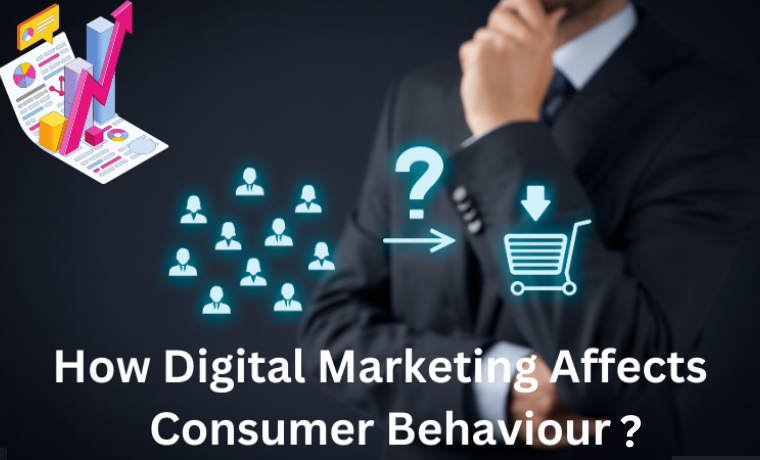Digital marketing influences consumer decisions by creating personalized, engaging, data-driven experiences.
Strategies like tailored content, interactive tools, and real-time personalization build trust and encourage action.
This article highlights key techniques that shape consumer behavior, including FOMO, social proof, and AI. Discover how brands adapt to preferences and foster lasting connections.
Methods by Which Digital Marketing Affects Consumer Behavior
Here are some methods through which digital marketing influences consumer behavior, helping businesses to understand their audience better and drive more effective decision-making.
Contact Personalization for Emotional Connection
Digital marketing enables businesses to connect personally with consumers through tailored interactions.
Using tools like email marketing, targeted ads, and personalized recommendations, companies can deliver content that aligns with individual preferences.
For instance, an email suggesting products based on past purchases makes consumers feel valued and understood, fostering trust and loyalty.
Personalized messages also capture attention more effectively than generic ads, cutting through the digital noise.
Real-time personalization, such as discounts for abandoned carts, motivates consumers to complete purchases.
Using audience segments helps create personalized ads, improve relevance, and enhance campaign performance.

Create FOMO Through Limited-Time Offers
Digital marketing leverages limited-time offers to create a sense of urgency using the Fear of Missing Out (FOMO).
Phrases like “Hurry, while stocks last” prompt consumers to act quickly, often leading to impulse buying.
Social media amplifies FOMO, spreading deals rapidly; for example, a flash sale on Instagram can reach thousands in minutes.
Exclusive offers, such as discounts for email subscribers or loyalty members, make consumers feel special and motivated to buy.
This psychological trigger influences consumer behavior, increasing sales, especially during peak shopping seasons or promotional events.
Utilize Social Proof Strategically
Social proof is a powerful tool in digital marketing that influences consumer behavior. Consumers often rely on online reviews, ratings, and testimonials to decide what to buy.
For instance, positive product reviews on an e-commerce site increase trust and the likelihood of purchase.
Featuring customer testimonials or sharing user-generated content on social media also builds credibility.
Influencers play a significant role in social proof by endorsing products.
Additionally, showcasing how many people have already purchased or used a product, like “10,000 customers love this,” boosts confidence.
Using social proof helps brands build trust and encourage consumer action.
Incorporate Interactive Content for Engagement
Interactive content is an effective way to engage consumers and influence their behavior. Unlike static ads, interactive elements like quizzes, polls, and games encourage active participation.
For example, a fashion brand may offer a “Find Your Perfect Style” quiz to help users discover products tailored to them.
This type of content grabs attention, keeps consumers engaged, and enhances their experience, increasing the likelihood of return visits or purchases.
Interactive content, including augmented reality (AR) tools like virtual try-ons for glasses or makeup, helps consumers make confident choices.
It builds trust, boosts conversions, and fosters long-term relationships with the brand.

A/B Testing to Understand Consumer Preferences
A/B testing is a powerful tool in digital marketing that helps businesses understand consumer preferences and behavior.
It involves creating two versions of an ad, email, or webpage and showing each to different groups of people.
Comparing results allows marketers to identify which version performs better. For instance, testing two email subject lines helps identify which one generates more clicks, allowing brands to optimize future campaigns.
A/B testing can evaluate everything from colors and images to call-to-action buttons. This data-driven approach improves marketing strategies, increases engagement, boosts sales, and makes consumers feel more connected to the brand.
Highlight Sustainability and Values
Modern consumers increasingly value sustainability and ethical practices, and digital marketing plays a crucial role in influencing their behavior.
Brands can create campaigns showcasing eco-friendly packaging, ethical sourcing, or donations to social causes.
When a brand aligns with consumers’ values, they feel more connected and are more likely to support it. Social media is key for sharing these messages and building trust.
Certifications like “Fair Trade” or “Carbon Neutral” can be highlighted in ads to assure authenticity.
Behind-the-scenes content showcasing sustainable processes further strengthens the brand’s commitment, fostering loyalty and encouraging ethical consumer decisions.
Improve for Mobile to Capture Micro-Moments
Consumers frequently turn to their smartphones for quick answers, searches, or purchases, known as micro-moments.
These moments significantly influence consumer behavior, and digital marketing can capture them by being mobile-friendly and accessible.
For instance, when a user searches for “best hotel near me,” a mobile-optimized website that loads quickly increases the chances of engaging them.
Mobile-friendly designs, simple navigation, and fast checkout processes encourage immediate action.
Tools like click-to-call buttons and location-targeted ads further enhance the mobile experience.
Prioritizing mobile optimization enables businesses to transform brief searches into meaningful interactions and conversions during these micro-moments.
Tap Into Behavioral Advertising
Behavioral advertising leverages consumer data, such as browsing history and past purchases, to deliver personalized ads.
This targeted approach enhances the effectiveness of digital marketing by presenting relevant content.
For example, someone who searches for running shoes may later see ads for sneakers or fitness gear across websites or social media. These tailored ads keep products top of mind, encouraging purchases.
Behavioral advertising companies reach the right audience by focusing on those with a previous interest in similar products.
This strategy not only increases conversions but also improves consumer experience, fostering stronger connections between consumers and brands.
Enhance Visual Appeal Through Short-Form Videos
Short-form videos have become a powerful tool in digital marketing, especially with platforms like TikTok, Instagram Reels, Facebook, and YouTube Shorts.
These quick, engaging videos allow brands to showcase products or services creatively. A 15-second clip can highlight key features or demonstrate how a product solves a problem.
In today’s fast-paced digital world, visually appealing videos grab attention quickly.
Consumers are more likely to remember content that is fun, emotional, or informative. Adding music, captions, and effects makes these videos even more engaging.
Delivering bite-sized content through short-form videos increases engagement, builds trust, and encourages purchases.
Analyze Data to Predict Trends
Data analysis plays a crucial role in digital marketing by helping businesses predict consumer trends and behaviors.
Studying data from online searches, social media business interactions, and purchase histories gives marketers insights into consumer preferences.
For example, if searches for eco-friendly products increase, a brand can launch targeted campaigns or new products to match the trend.
Data also reveals seasonal patterns, like higher demand for fitness gear during the New Year. Predicting trends helps businesses stay ahead of competitors.
Using tools like Google Analytics and social media insights, brands create personalized marketing strategies that drive engagement, loyalty, and sales.
Capitalize on Localized Marketing
Localized marketing tailors digital campaigns to specific areas or communities, helping businesses connect with consumers by addressing their local needs and culture.
For instance, a restaurant might offer discounts or feature dishes inspired by local cuisine. Geotargeting uses location data to ensure ads reach the right audience at the right time.
This strategy also works well with events and festivals, such as promoting winter wear during a local cold spell or creating content for a regional holiday.
Making marketing feel relevant and personal helps businesses build stronger connections, boost sales, and increase loyalty, as consumers value the brand’s understanding of their community.
Gamify Shopping Experiences
Gamification enhances the shopping experience by making it more fun and engaging, which influences consumer behavior. It incorporates game-like elements such as rewards, challenges, and competitions.
Brands can offer points or badges for actions like making a purchase, leaving a review, or sharing a product on social media, which can be redeemed for discounts or exclusive rewards.
Spin-the-wheel games or treasure hunts on e-commerce sites add excitement and make shopping feel like entertainment. This sense of achievement encourages consumer loyalty.
Making shopping enjoyable through gamification enhances engagement, drives sales, and strengthens the bond between consumers and brands.
Attachment of AI-powered chatbots
AI-powered chatbots are transforming business-consumer interactions, influencing behavior in many ways.
These chatbots offer instant, 24/7 assistance by answering questions, providing recommendations, and guiding consumers through their shopping journey.
For instance, if a customer needs a website, a chatbot can suggest products based on preferences or past purchases, making the shopping experience faster and easier.
Chatbots also help with tasks like order tracking, issue resolution, and sharing promotions. Their friendly, efficient communication makes consumers feel valued.
Integrating chatbots on websites, apps, or social media helps businesses build trust, increase loyalty, and improve customer satisfaction.
Monitor Sentiment in Real Time
Real-time sentiment monitoring enables businesses to understand how consumers feel about their brands, products, or campaigns.
Digital tools and social media analytics track customer opinions by analyzing comments, reviews, and posts.
For instance, if a new product launch receives positive mentions, it indicates a successful campaign, while negative feedback helps identify issues that need addressing.
Staying connected and responding promptly, such as apologizing for mistakes or thanking customers for positive feedback, shows brands care about consumer opinions.
This approach builds trust, strengthens customer relationships, and boosts satisfaction, ultimately encouraging loyalty and repeat purchases.
Experiment with Virtual Experiences
Virtual experiences are becoming a powerful tool in digital marketing, allowing consumers to interact with products in new, exciting ways.
Virtual reality (VR) and augmented reality (AR) give customers the chance to try out products before buying, without leaving their homes.
For example, furniture stores use AR to let customers see how a couch would look in their living room. Beauty brands utilize AR to let users virtually try on makeup.
These experiences help consumers feel more confident in their decisions, reducing hesitation and the chance of returns.
These technologies also increase consumer engagement and drive sales by offering a more immersive, hands-on experience.
Brandout Can Help You Understand Consumer Behavior and Craft Targeted Marketing Strategies
Digital marketing works best when you understand your audience.
Brandout’s digital marketing service specializes in analyzing consumer behavior to create tailored strategies that resonate with your users.
We help you design marketing campaigns that engage your audience and drive conversions based on their preferences and behaviors.
Conclusion:
Digital marketing has transformed the way consumers interact with brands, shaping their decisions through personalization, social proof, and innovative tools.
Using real-time data and emotional connections, businesses create meaningful experiences that resonate with their audience.
From tailored ads to interactive content and FOMO-driven campaigns, these strategies influence not just what consumers buy but also how they perceive and trust brands.
As technology evolves, the impact of digital marketing on consumer behavior will continue to grow, offering endless opportunities to build stronger, lasting relationships.
Frequently asked questions:
How does marketing affect consumer buying behavior?
Marketing shapes buying behavior by creating awareness, influencing perceptions, and addressing needs. It appeals to emotions, highlights benefits, and uses social proof to drive decisions.
How does digital marketing impact the consumer decision-making process?
Digital marketing simplifies decision-making with personalized ads, reviews, and interactive content. It guides consumers through awareness, consideration, and purchase stages, offering real-time support.
How is consumer behavior evolving in the digital marketplace?
Consumers now demand personalization, convenience, and trust. They rely on reviews, prefer mobile-friendly experiences, and value sustainability and ethical practices in brands.
How does the consumer decision-making process impact marketing strategies?
The decision-making process drives marketing strategies to target specific stages. Brands use awareness campaigns, detailed B2B SAS content marketing, and purchase incentives to align with consumer needs.








